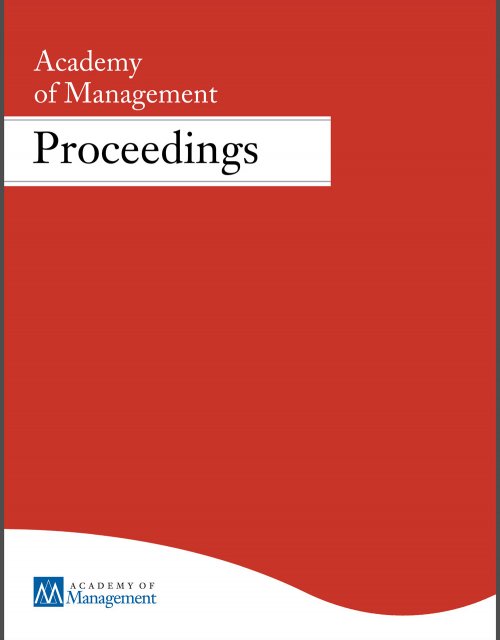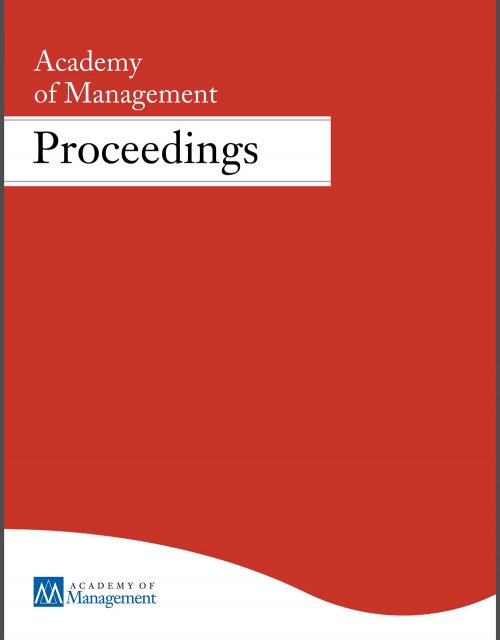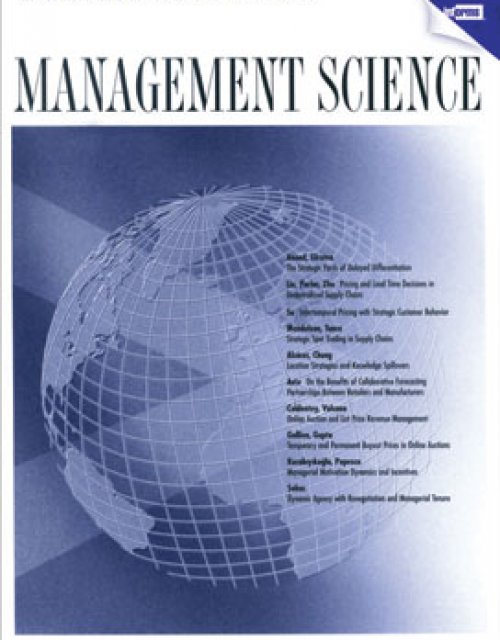Publication records
Subject(s)
Human resources management/organizational behavior
Keyword(s)
Dark triad, self-uncertainty, motivation to lead, hostile attributions, leadership support, experiment
We propose a two-fold explanation, based on self-related uncertainty, to explain why individuals with antisocial personalities may be more likely to attain leadership positions in the upper echelons of organizations. First, in three experiments (Ns = 141, 238, and 602), we showed that individuals who score high on the dark triad of personality (i.e. psychopathy, narcissism and Machiavellianism) react to the distress associated with self-related uncertainty through enhanced hostility against others, which in turn increases their motivation to lead. Second, in two correlational studies (Ns = 58 and 87) and one experiment (N = 180), we found that hypothetical and actual leaders with psychopathic traits are more likely to be supported by individuals who feel uncertain about their own sense of self. Together, our results provide evidence of the significant role played by self-uncertainty in explaining why and when dark triad individuals are able to attain leadership positions. We discuss implications for theory and research on the dark triad, leadership, and identity, and their relevance for understanding both organizational and public leadership.
With permission of the Academy of Management
Volume
2018
ISSN (Online)
2151-6561
ISSN (Print)
0065-0668
Subject(s)
Human resources management/organizational behavior; Strategy and general management
ISSN (Print)
0017-8012
Subject(s)
Human resources management/organizational behavior
Keyword(s)
Age, innovative behavior, inter-departmental collaboration, personnel outcomes
Although the topic of aging at work is receiving increasing research attention, it remains unclear if aging employees are less innovative at work and what consequences this relation entails. We integrate the literature on aging with research on innovation to gain a better understanding of whether—and if so, when—employees’ aging harms their professional outcomes via decreased innovative behavior. Multi-source, time-lag data on 305 project managers provides support for the idea that age does not always go hand in hand with low innovative behavior and, subsequently, low professional outcomes. Rather, inter-departmental collaboration works as a social buffer for these negative effects. Specifically, aging employees with low inter-departmental collaboration are less innovative and subsequently less successful. In contrast, the “age handicap” vanishes when aging employees collaborate with other members in their organizations. Our results highlight the importance for organizations to foster collaboration among their members, either formally or informally.
With permission of the Academy of Management
Volume
2018
ISSN (Online)
2151-6561
ISSN (Print)
0065-0668
Subject(s)
Human resources management/organizational behavior
Keyword(s)
Negotiation, alternatives, power, first offer, mental simulation
The present research demonstrates that negotiators can act powerfully without having power. Researchers and practitioners advise people to obtain strong alternatives prior to negotiating to enhance their power. However, alternatives are not always readily available, often forcing negotiators to negotiate without much, or any, power. Building on research suggesting that subjective feelings of power and objective outcomes are disconnected and that mental simulation can increase individuals' aspirations, we hypothesized that the mental imagery of a strong alternative could provide similar psychological benefits to having an actual alternative. Our studies demonstrate that imagining strong alternatives causes individuals to negotiate more ambitiously and provides them with a distributive advantage: negotiators reached more profitable agreements when they either had a strong tendency to think about better alternatives (Study 1) or when they were instructed to mentally simulate an attractive alternative (Studies 3-4). Mediation analyses suggest that mental simulation boosts performance because it increases negotiators' aspirations which translate into more ambitious first offers (Studies 2-4), but only when the simulated alternative is attractive (Study 2b). Our findings further show that mental simulations are only beneficial when there is sufficient room in the negotiation to reach a profitable agreement, but backfire in settings where negotiators' positions are difficult to reconcile (Study 5). An internal meta-analysis of the file-drawer produces effect size estimates free of publication bias and demonstrates the robustness of the effect. Our findings contribute to research on social power, negotiations, and mental simulation.
Copyright © 2018 American Psychological Association.
Reproduced with permission.
Volume
115
Journal Pages
96–117
ISSN (Online)
1939-1315
ISSN (Print)
0022-3514
Subject(s)
Product and operations management
Keyword(s)
Pricing, choice behavior, rational inattention, information acquisition, signaling game
We study the optimal pricing problem of a monopolistic firm facing customers with limited attention and capability to process information about the value (quality) of a single offered product. We model customer choice based on the theory of rational inattention in the economics literature, which enables us to capture not only the impact of true quality and price, but also the intricate effects of customer’s prior beliefs and cost of information acquisition and processing. We formulate the firm’s price optimization problem assuming that the firm can also use the price to signal the quality of the product to customers. To delineate the economic incentives of the firm, we first characterize the pricing and revenue implications of customer’s limited attention without signaling, and then use these results to explore Perfect Bayesian Equilbiria (PBE) of the strategic pricing signaling game. As an extension, we consider heterogeneous customers with different information costs as well as prior beliefs. We discuss the managerial implications of our key findings and prescribe insights regarding information provision and product positioning.
© 2017, INFORMS
Volume
64
Journal Pages
2995–3014
ISSN (Online)
1526-5501
ISSN (Print)
0025–1909
Subject(s)
Human resources management/organizational behavior; Marketing
Keyword(s)
Sales, leadership, price negotiations, salesperson–customer interaction, transformational leadership, social learning
JEL Code(s)
M310
Volume
46
Journal Pages
703–724
Subject(s)
Economics, politics and business environment
Keyword(s)
Default options, online platforms, charitable giving, field experiment
JEL Code(s)
D03, D01, D64, C93
Pages
92
ISSN (Online)
2190-9938
Subject(s)
Technology, R&D management
Keyword(s)
Patent, pharmaceuticals, drug development
Firms in the pharmaceutical industry typically rely on a period of market exclusivity derived from patent protection and data exclusivity to recoup their investments in R&D. The invalidation of patent rights during drug development renders data exclusivity the sole source of protection and shifts the period of market exclusivity at the project level. Invalidation therefore constitutes a natural experiment that allows us to identify how the duration of market exclusivity affects firms' incentives to innovate. Our analysis is based on a novel data set that links the development histories of drug candidates with underlying patent data. We identify causal effects relying on an instrument for the potentially endogenous patent invalidation. Our findings highlight that shorter durations of market exclusivity reduce the hazards of successful drug commercialization.
With permission of the Academy of Management
Volume
2018
ISSN (Online)
2151-6561
ISSN (Print)
0065-0668
Subject(s)
Economics, politics and business environment
While we know much about how networks shape organizational performance, we know less about the linkages between networks and performance in the aftermath of exogenous, industry-wide shocks. We examine how the dot-com crash of 2000 affected investment banks’ ability to convert three facets of their positions in inter-firm networks–structural holes, status and fragility–into future performance. We find that the post-crisis performance of banks rich in structural holes does not exceed that of banks in closed networks. Conversely, high-status banks lose their advantage relative to low-status banks, while banks in fragile network positions outperform their robustly positioned peers. External shocks can thus turn the tables–dethroning organizations in typically advantaged network positions, while also opening up new opportunities for their fragile counterparts.
With permission of the Academy of Management
Volume
2018
ISSN (Online)
2151-6561
ISSN (Print)
0065-0668
Subject(s)
Economics, politics and business environment; Entrepreneurship
What should a CEO do to increase the social multiplier of a startup? What organizational strategy, in other words, should a manager adopt to shape informal social interactions among employees, so that they perform better in the office than if they telecommuted? We develop a network-based model that contrasts two opposing approaches. The first, consistent with Coleman’s vision of social capital, is embedding. Using an embedding strategy, the CEO fosters strong and dense ties among employees, and thus seeks to raise productivity by facilitating knowledge spillovers and creating social pressure. The second, keeping with White’s theory of social control, is decoupling. Using a decoupling strategy, the CEO promotes weak and sparse connections among employees, and so tries to increase productivity by minimizing distraction. Our findings indicate that, while embedding is generally preferable to decoupling for most kinds of organizations, decoupling is clearly preferable when two conditions are jointly met: the organization’s distribution of human capital is left-skewed and it is populated more by “slackers,” who “look down” in order to self-enhance, than by “climbers” who “look up” to self-improve. Our results also suggest that the zone of network irrelevance–that is, the space of possibilities over which the CEO’s efforts to rewire the network will prove inconsequential–paradoxically contracts as the firm grows: counter to a prevailing picture of small firms as inherently malleable, our model suggests that a CEO achieves less through shaping informal social interactions when the organization is not yet at scale. Implications for future research on networks and organizations are discussed.
With permission of the Academy of Management
Volume
2018
ISSN (Online)
2151-6561
ISSN (Print)
0065-0668



